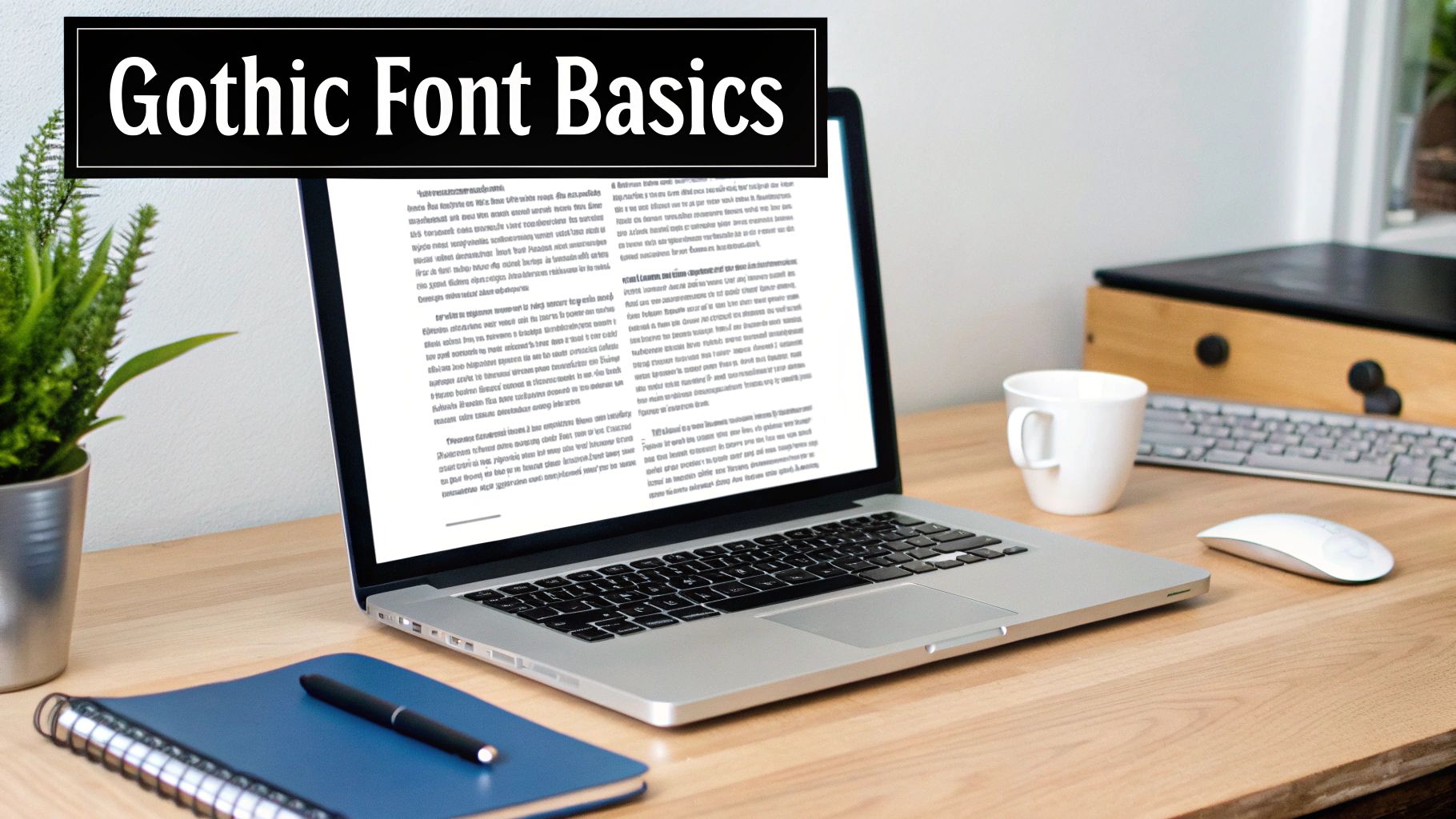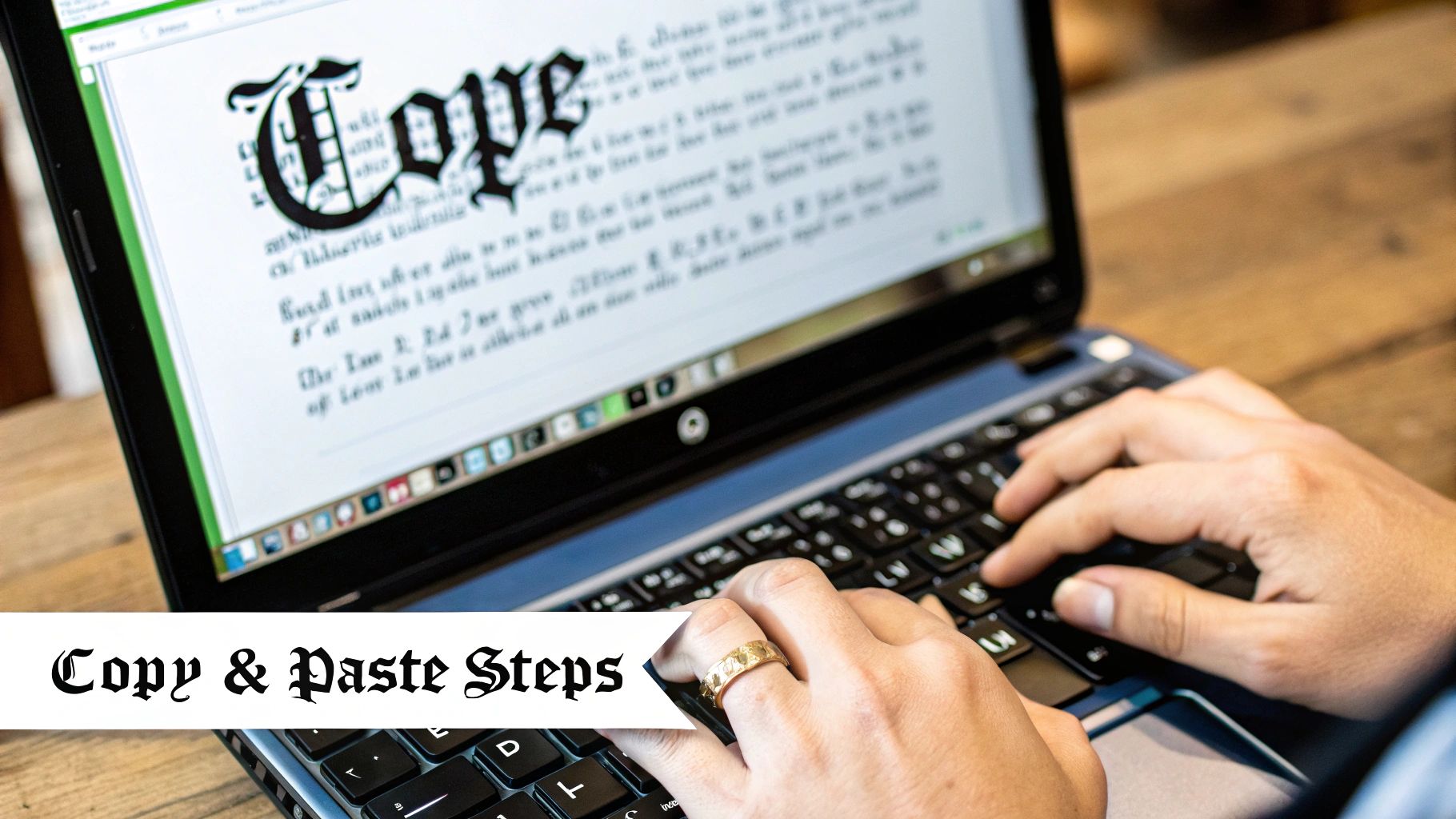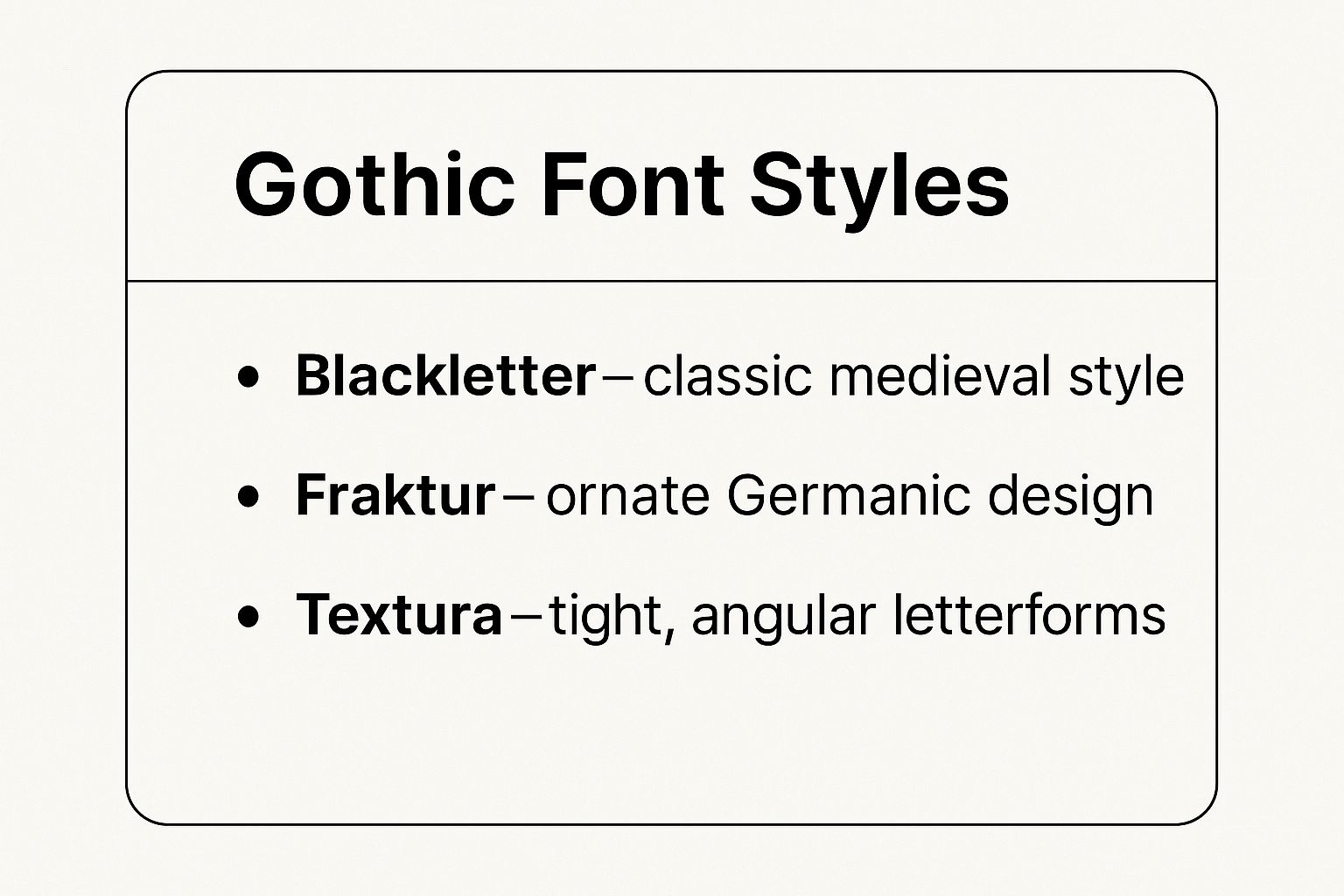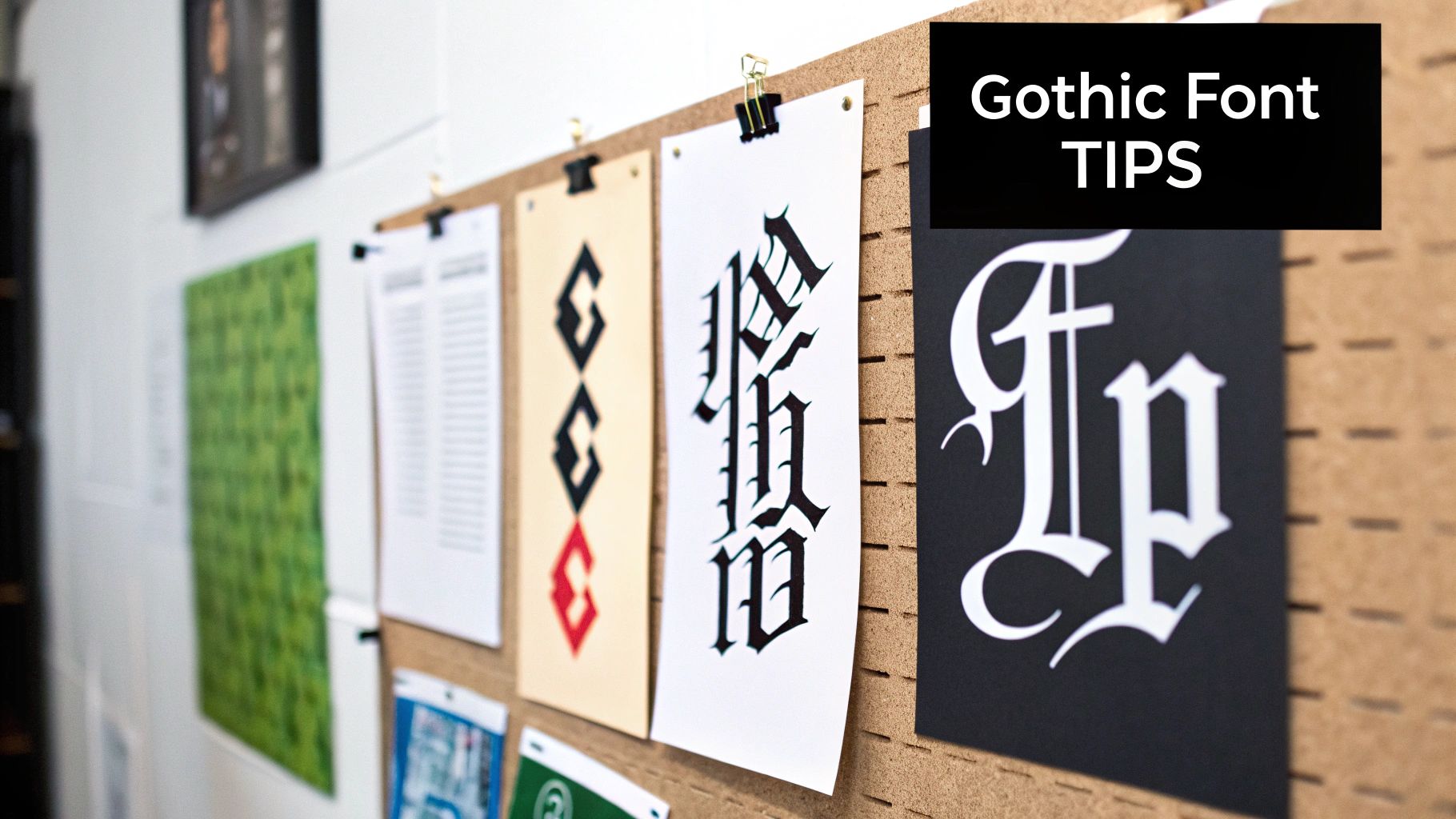If you're looking to add a bit of dramatic, medieval flair to your social media bios or gaming profiles, a gothic font copy paste tool is your fastest route. You just type your text into an online generator, and it’ll spit out a stylised version you can paste pretty much anywhere.
Why Gothic Fonts Still Dominate Digital Style

Ever spotted those intricate, old-world fonts in really modern settings? Think of a musician's Instagram handle or a fantasy gamer clan's Discord server—the gothic aesthetic is everywhere. Its lasting appeal isn’t a fluke; it comes from a rich history that gives the style a powerful, ready-made personality.
Gothic fonts, also known as Blackletter typefaces, actually trace their origins back to medieval Europe. They really took hold in the UK during the 14th and 15th centuries, becoming central to the country's written heritage. These scripts were used for everything from handwritten manuscripts to the very first printed books, long before Roman typefaces took over. You can dive deeper into the fascinating history behind this typeface to see just how deep its roots go. It’s this historical weight that makes these fonts so impactful today.
The Modern Appeal of an Ancient Style
In a digital space saturated with clean, minimalist sans-serif fonts, gothic lettering makes a statement. It’s got an undeniable character that can broadcast a whole vibe without you having to explain a thing, which makes it a fantastic tool for personal branding.
So, what makes it so versatile?
- A Sense of Authority: The font’s formal, structured look can give off an air of tradition and seriousness.
- An Edgy Rebellion: On the flip side, its sharp angles are often co-opted by counter-cultures like punk and metal to signal a departure from the mainstream.
- A Touch of Mystique: For fantasy genres or brands going for that "dark academia" feel, the font adds an instant layer of mystery and elegance.
The real beauty of using a gothic font copy paste generator is how easy it is. You don't need fancy design software or a degree in typography to tap into this powerful aesthetic anymore.
An AI font generator makes it even simpler, offering up creative variations you can grab in seconds. This opens the door for anyone to inject their online presence with a style that is both historically significant and incredibly current. It’s a direct link to an aesthetic that just feels timeless.
How Copy and Paste Fonts Actually Work
Ever wondered how you can get a gothic font copy and paste to work in your Instagram bio, where normally only plain text is allowed? It’s a clever trick, but it isn’t magic. You’re not actually pasting a font file at all.
The secret is something called Unicode.
Instead of bundling text into a font that someone has to install, an AI font generator cleverly scours the enormous Unicode library for special characters that just look like gothic letters. It then stitches these characters together to spell out your words. So, you're not copying a style; you're copying a specific sequence of symbols that gives the illusion of a custom font.
The Power of Unicode
Think of Unicode as a universal translator for every character you can imagine. It’s a massive digital dictionary that contains everything from a simple 'A' to an emoji '😊' and thousands of other stylistic and mathematical symbols.
- Every single character gets its own unique code.
- Pretty much every modern device, app, and website is built to read and display these codes.
- Our AI font generator simply finds the codes for symbols that look like gothic letters (for example, 𝔊𝔬𝔱𝔥𝔦𝔠 𝔗𝔢𝔵𝔱).
This is exactly why the text works perfectly when you paste it into places that don’t support custom fonts, like social media comments, usernames, or messaging apps. Your device is just displaying a string of unique characters.
The AI font generator isn't really changing the font. It’s just swapping your standard letters for different, more ornate characters that already exist within the Unicode system. This is the simple principle that makes all copy-and-paste styling possible.
Back in the day, Blackletter fonts were all over printed materials in the UK, but their popularity faded during the 16th and 17th centuries as cleaner Roman typefaces took over. Yet, the gothic style never truly disappeared, sticking around for ceremonial documents and titles, which shows its lasting cultural impact. Now, that legacy has found a new life online thanks to Unicode.
For more inspiration, you should check out our guide on free fonts for designers to find some real gems for your next project.
Getting Started with an AI Font Generator

Right, let's get to the fun part. Using an AI font generator is where your creative ideas start to take shape. The best thing about these tools is their simplicity. There’s no clunky software to download or install; you just open a webpage and get straight to work, styling your text in a few clicks. The whole process is designed to take you from a simple idea to a ready-to-use gothic font in less than a minute.
You'll notice that most generators have a very clean, simple interface, much like the one pictured above. This is intentional. It means you can focus on being creative rather than getting bogged down trying to figure out how the tool works.
Bring Your Text to Life
Your first move is as simple as it gets: just type or paste whatever you want to stylise into the input box. It could be a single powerful word for a logo concept, a snappy phrase for a t-shirt, or a full sentence for your social media profile. The moment you enter your text, the AI engine kicks in.
Almost immediately, the tool will churn out your text in a huge range of gothic styles. You'll see everything from classic, ornate Blackletter fonts to more subtle, contemporary takes on the gothic aesthetic. This is your chance to play around—scroll through the list and see which style really speaks to the vibe you're trying to create.
Here's a tip from experience: don't just grab the first font you like. I always make a point to scroll down a bit further. More often than not, I stumble upon a unique variation I hadn't even considered, and those subtle differences can completely change the final impact.
Copy, Paste, and Go
Found the one? Perfect. Getting it out of the AI font generator is just as easy. Next to each font style, you’ll find a 'copy' button. One click is all it takes to load those special Unicode characters onto your clipboard.
Now you can head over to wherever you plan to use it—your Instagram bio, a Discord channel, or even a design project. Just right-click and 'paste', or use the good old keyboard shortcut (Ctrl+V on Windows, Cmd+V on a Mac), and your stylised text will appear instantly.
Wondering where you could use this? Here are a few ideas to get you started:
- Instagram Bio: Make your profile pop and stand out from the endless scroll.
- Discord Server Name: Give your community a cool, thematic identity that members will love.
- YouTube Video Titles: Add a bit of visual spice to grab a viewer's eye in a crowded feed.
This whole process is a brilliant, small-scale example of creative automation. If you're interested in how this works on a larger scale, it’s worth understanding content automation and how it's changing the way we create. Using an AI font generator frees you up to focus on the bigger, more strategic parts of your project.
Choosing the Right Gothic Style for Your Vibe
It’s easy to lump all gothic fonts together, but that’s a rookie mistake. "Gothic" is actually a broad term for a family of historical scripts called Blackletter, and the differences between them are huge. When you fire up an AI font generator, you’ll be met with a tonne of variations, each with its own distinct personality.
Getting the mood right depends entirely on picking the right style. Some look ancient and imposing, perfect for a fantasy novel cover or a historical project. Others have a more modern, edgy feel that’s great for a band’s Instagram or a streetwear brand. Understanding the nuances means you can make a deliberate choice, rather than just grabbing the first gothic font copy paste option you see.
This image breaks down the three main families of Blackletter you'll most likely come across.

You can see straight away how different they are. From the tight, almost woven appearance of Textura to the more decorative and famously "broken" shapes of Fraktur, these visual traits are what give each style its unique character.
Finding Your Perfect Gothic Match
So, how do you pick the one for you? It all comes down to the story you're trying to tell. Are you designing a logo for a gaming clan that needs to look powerful and aggressive? Or maybe you’re after that classic "dark academia" vibe for your personal blog?
Here’s a quick guide to help you choose:
- Textura: This is what most people picture when they think "medieval." It’s defined by tall, narrow letters that are incredibly angular, creating a dense texture across the page. Reach for this when you need something that feels genuinely historical and formal.
- Fraktur: Hailing from Germany, Fraktur is far more ornate. It’s famous for the "broken" curves that give Blackletter its name. This style is a real showstopper and works brilliantly for headlines, logos, or anywhere you need a massive visual impact.
- Schwabacher: Think of this as the friendlier, more approachable member of the gothic family. The letters are rounder and wider, with more open curves that make it a bit easier to read than its spikier cousins. It's a solid choice if you want a gothic feel without the full-on intensity.
To make it even clearer, I've put together a table comparing the most common styles you'll find in a font generator.
Comparison of Common Gothic Font Styles
| Style Name |
Key Characteristics |
Best For |
| Textura |
Tall, narrow, angular, dense "woven" texture. |
Historical documents, formal invitations, fantasy themes. |
| Fraktur |
Ornate, decorative, with "broken" curves and bows. |
Headlines, logos, metal band merch, high-impact branding. |
| Schwabacher |
Rounder, wider letters, more open curves. |
A slightly softer, more readable gothic look; book titles. |
Ultimately, picking a font is about matching it to your message. The best way to figure it out is to simply play around in an AI font generator and see what feels right.
The best style is always the one that reinforces your message. If your brand is rebellious and loud, a sharp Fraktur might be perfect. If it’s mysterious and scholarly, a classic Textura will serve you better. Experimenting is the fastest way to see what works.
Making Your Gothic Text Look Professional

It’s one thing to find a cool font, but knowing how to use it is what really makes your design look polished. When you gothic font copy paste, you're aiming for impact without making your text impossible to read. That’s the real trick. These old-world, ornate characters can quickly become a jumbled mess, especially on a small phone screen.
Think of it this way: less is more. Drowning an entire block of text in a heavy Blackletter script is a surefire way to make people give up reading. A much smarter move is to use your chosen gothic font for a punchy headline or to highlight a couple of important words, then let a clean, simple font do the rest of the work.
The secret to a professional look is contrast. By pairing intricate gothic characters with a minimalist font, you make the decorative text pop. This contrast naturally tells your audience where to look first.
You can also get creative by mixing things up. Try blending gothic letters with standard text or even emojis to give a classic style a modern, almost edgy feel. For example, you could stylise just the first letter of a word or use specific gothic symbols as dividers or accents.
Ensure Cross-Platform Consistency
Here’s a step people often miss: checking how your text looks across different devices. Unicode characters don’t always render the same way on an iPhone as they do on an Android, or on a Windows machine versus a Mac.
What looks sharp and clear on your screen might be a broken, jumbled mess on someone else's. Before you hit publish, take a moment to double-check.
- Test on different devices: Ping the text over to a friend who uses a different phone.
- Check various browsers: If you're using it on a website, open it in Chrome, Firefox, and Safari to see how it holds up.
- Be ready to tweak: You might need to swap to a slightly different gothic style that’s more universally compatible.
Spending an extra minute on this can make all the difference, ensuring your design lands just right for everyone. For more ideas on text styling, our guide on https://aifontgenerator.com/blog/bold-italic-fonts has some great tips. And remember, fonts can be creative works, so it's always wise to understand copyright law to make sure your amazing designs are also above board.
A Few Common Questions About Gothic Font Generators
When you first start playing with a gothic font copy paste tool, it’s natural for a few questions to come up. People often run into the same little hurdles, from weird technical glitches to wondering about professional use. Let's tackle some of the most common uncertainties so you can use these fonts confidently.
One of the biggest head-scratchers is when your beautifully crafted gothic text shows up as a bunch of empty squares (☐☐☐). This isn't a bug in the AI font generator; it's a compatibility issue. It means whatever device or platform you're viewing it on doesn't support the specific Unicode characters used to create the style. Most modern apps handle them just fine, but you might hit a wall with older systems. A quick tip? Before you post something important, send it to a friend with a different phone to see how it looks on their end.
Can I Use These Professionally? What About SEO?
A lot of people ask if they can pop these fonts into their professional work, like in Google Docs or Microsoft Word. The short answer is yes, you can paste the text in. But it's crucial to understand it won't act like a normal font. It’s essentially a string of special symbols, so you can’t just highlight another word and apply the "gothic" style to it. If you need consistent, professional typography, your best bet is always to install a proper font file (.ttf or .otf).
For anyone running a website, the big question is always SEO. Here's the deal: using these fancy Unicode characters from an AI font generator for important text like your page titles or H1 headings is a bad idea. Search engines might struggle to read them, and that could really hurt your rankings.
It's much safer to keep these decorative styles for things where search engine crawlers don't matter, like spicing up your social media bio or adding a little flair to a graphic.
And if you're thinking about using these styles for commercial projects, licensing is something you'll need to consider. We break this down in our guide on understanding font licensing for commercial use.
Ready to start creating your own eye-catching text? The AI Font Generator has over 1,400 unique fonts waiting for you. Give it a go for free and see what you can design at https://aifontgenerator.com.